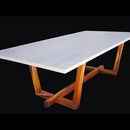Introduction: Basic Hardwood Step Stool
Hey Instructables Community!
I made this step stool on a whim just because I was standing on paint buckets and chairs around the house and the shop and frankly I felt like I was going to eat it at any time. This is made out of two hardwoods, tiger wood (fancy) and ash (less fancy) and is joined together with screws covered by dowels in a box joint configuration.
I tried to do this pretty basic for folks out there that don't have a lot of tools. I used primarily a table saw, band saw, and a drill and driver. Some helpful tools too are a marking gauge and some sort of flush trim hand saw. The finish is a hand rubbed finish.
Get to work!
Step 1: Breaking Down Lumber and Setting Up Stock
I started by breaking down my lumber with my track saw. I had a rather large piece of tigerwood and some off cuts of six quarter ash from another build. Everything was surfaced on one side already, so I cut the tiger wood down to match the width of the ash boards and then used the track saw to joint the ash boards on one side. A track saw is pretty solid alternative to a jointer assuming you have at least one surfaced side.
I then took everything over to the table saw to trim up the opposing side and made sure all my boards were the same width.
To get the other face surfaced, I went ahead and skip planed these with my lunchbox planer and double checked that each species of wood had consistent thickness. The idea being that the ash would be the vertical supports and the tiger wood would be the horizontal steps of the stool.
I then marked everything off and cross cut them to width. The vertical supports will be a glue up of two different lengths of ash, so I’m just ensuring that both sides are identical and flushing everything up with my miter gauge.
Step 2: Joinery
Now for joinery I’m going to do a chubby finger joint of sorts, so I’m just using a marking gauge to mark out the opposing board’s thickness and then a speed square to line up north-south cuts before taking this over to the bandsaw.
I don’t have a dedicated bandsaw fence so I’m using my speed square clamped to its bed to keep everything straight.
I cut the tigerwood steps to width and then used the marking gauge again, measuring off that thick ash to line up the finger joint on the tiger wood. I cut the straight cuts with the fence hack on the bandsaw, but then drilled some relief holes in the waste to help make the corner turn easier since tigerwood is extremely dense.
Next I glued the ash boards together on the edge grain to create a lower and upper step. After that was dry, I used a hole saw to create a semi circle detail that would make four distinct feet and cleaned it up on the spindle sander.
Then I clamped everything together for a dry fit and pre-drilled some counter bores to accept a 2 ½ inch screw before applying glue, reclamping, and drilling into place. I wiped away squeeze out with a damp towel.
Step 3: Assembly
I cut some plugs with a plug cutter to hide the screws, alternating the wood species to create some contrast in the surface. I tapped those in with a mallet and later flush trimmed those to the surface.
The next day, I went ahead and broke out the large orbital sander/polisher and sanded the hell out of this thing, making sure to flush up all the surfaces and ends. After sanding to 320, I used my router with a chamfer bit to chamfer the forward and rear edges for a lighter look and then card scraped all the exterior surfaces for a finish ready surface.
I then took a couple minutes to brand the side with my logo, giving it a light sand after with 320 grit.
Step 4: Finish
I went with a homemade finish consisting of equal parts boiled linseed oil and wipe on poly. I applied a couple coats of that, wiping off excess, and after a day of dry time added a second finish of equal parts boiled linseed oil, pure tung oil, and beeswax. I heated the finish mixture in the microwave for about 40 seconds and stirred in the beeswax before applying and wiping off excess. After another two days of dry time, the stool was done.
Enjoy guys and don't forget to follow me on Instagram and check out the full build video on YouTube!




